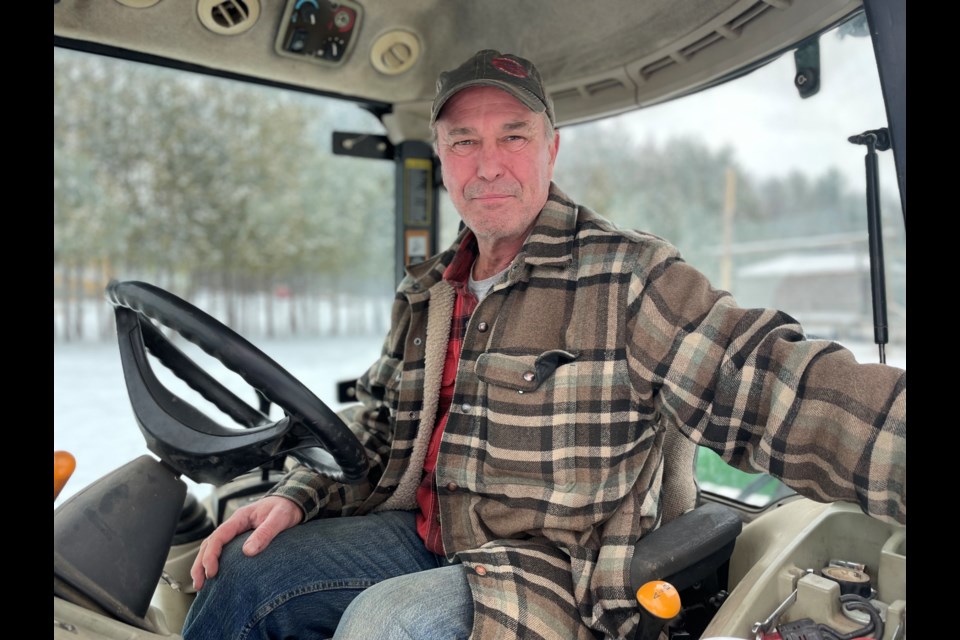Building an outdoor skating rink can take a lot of patience, time, and money, but perfecting the craft makes it all worthwhile for Richard Cordery.
During the pandemic, when local arenas were shut down, Cordery invited various hockey teams and figure skating clubs in the area to practise on his 75-by-150-foot, fully lit ice rink on the property of his shop and home on Fairgrounds Road.
Cordery, the owner of Cordery Electrical Contracting Inc., began making the rink four years ago by accident. In 2019, he dug out 18 inches of topsoil in his backyard to create a pond, and then in the fall, the wet, cold, and miserable weather transformed it into an ice rink.
"A couple of the guys who work here just went out walking on it," he said. "They said underneath the snow was ice, so I took the tractor out there, blew a bunch of snow off, and they were skating on it."
In the summer of 2020, Cordery levelled out the pond, which never happened, with the hopes that the water from the fall weather would level out and form perfectly like it did the year before.
"It just didn't freeze all the way down like it did before," he said. "So, I ended up out there with a snow blower and water pump, breaking up ice and sucking water out of it."
Cordery, 59, learned that year he would have to keep water out of the rink area in the fall to keep it dry, otherwise, it wouldn't freeze all the way through in the winter. He also now spends the summer months keeping weeds out of the ice rink area, otherwise, they end up coming through the ice.
"It would have been easier if I didn't take that topsoil off and I just sort of flattened things out so water wouldn't be laying in there," he explained. "That adds another step with getting pumps involved and keeping the water off of it while things are getting cold."
In the winter of 2021, Cordery got inventive, making his own custom Zamboni. It consists of a 1,000-litre water tote that sits on a trailer that is pulled behind his tractor. Also attached to the makeshift ice resurfacer is a towel that drags behind it to spread out the water.
"A 1,000-litre tote adds about a quarter inch of ice to the rink," Cordery explained. "It repairs whatever damage has been done from skating on it and flattens it out again."
Cordery also uses a grader blade to scape bumps out of the ice, which can be pretty time consuming.
"My ice isn't like arena ice," he explained. "It's much harder when it gets cold, so it's harder to scrape."
From the fall until the time the rink melts away in the spring, Cordery spends, on average, an hour a day on the rink. Last weekend, he spent 14 hours outside trying to smooth out wet spots.
"It's always best if I can clear it right away every time it snows," he explained. "Snow is an insulator, so if you have warm ground underneath, and then ice, and then snow on top of it, it will start to melt the ice, which creates soft spots where the water comes up."
If temperatures consistently stay well below freezing next week, as they are currently forecast, Cordery says it won't take long for his rink to take perfect shape.
"I have a bit of a base out there now," he said. "If I can get any soft slush out there off, it will let it freeze in temperatures around minus 10."
Once the rink has been established, warmer temperatures in the daytime aren't always a bad thing.
"If I can get four to six inches of ice out there, there's no water underneath, no snow on top, and we get a mild day, it will really help the rink sometimes," he said. "A mild sunny day and a cold winter night can soften up the top, level everything out, and make it like glass."
If there is water underneath the rink on a warm day, it creates soft spots, he explained.
"You can see it because they are brown, dinner plate-sized spots," he said. "That's the mud coming up through the ice."
Last year, although not for a lack of trying, Cordery never got his rink to work.
"Every time I would get it close, we would get a mild spell," he said. "If the weather isn't on your side, you can't do anything."
Each year, it feels as if Cordery's window for building the rink gets shorter.
"We are not able to think about making ice now before Christmas," he said. "The earliest I ever had anyone skating here was Nov. 22 in 2019."
Cordery, a native of Reading, England, who immigrated to Canada with his family in 1967, says the weather is "definitely" changing and he fears that one day there won't be outdoor rinks that aren't equipped with chillers.
"Our winters are getting lighter than what they used to be," he said. "When I was in high school, I can remember going skating on Lake Couchiching in between Christmas and New Year's."
Despite the hiccups that can come with building a rink and the ever-changing weather conditions, it's become a winter hobby for Cordery to try and perfect his craft for his employees, friends, and family who use the rink.
"Every time I bring the tractor on the rink, it sucks up a few gallons of diesel," he said. "Building the rink can be expensive and, at times, kind of frustrating, but once you get the ice here, it's fun and games."
